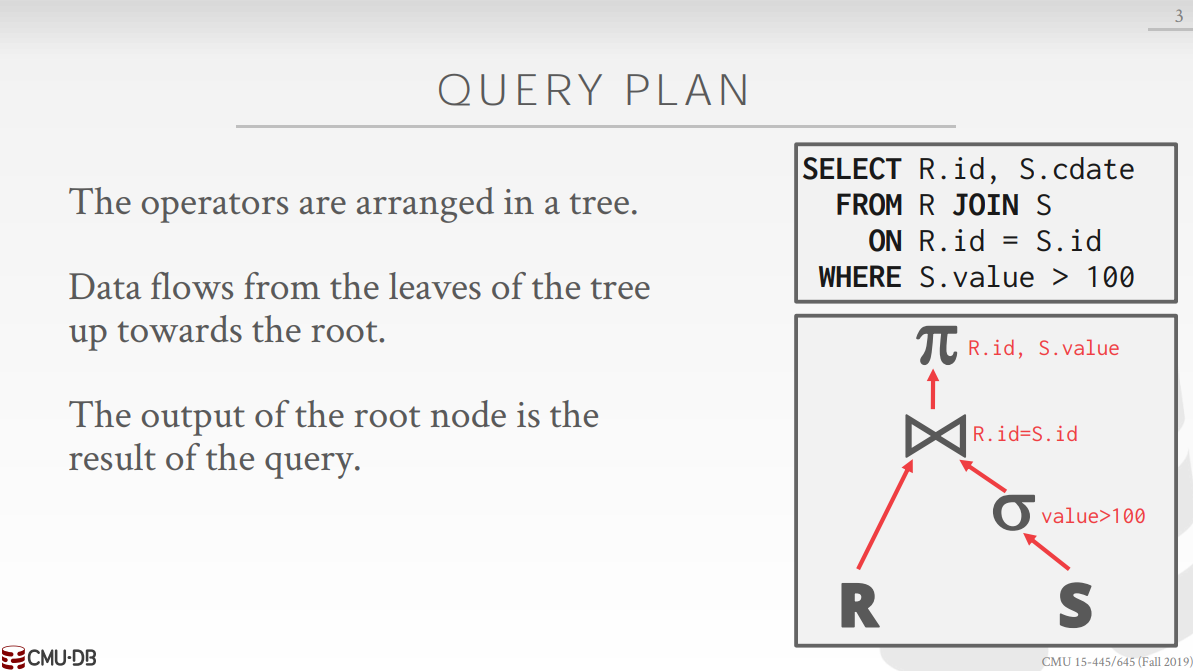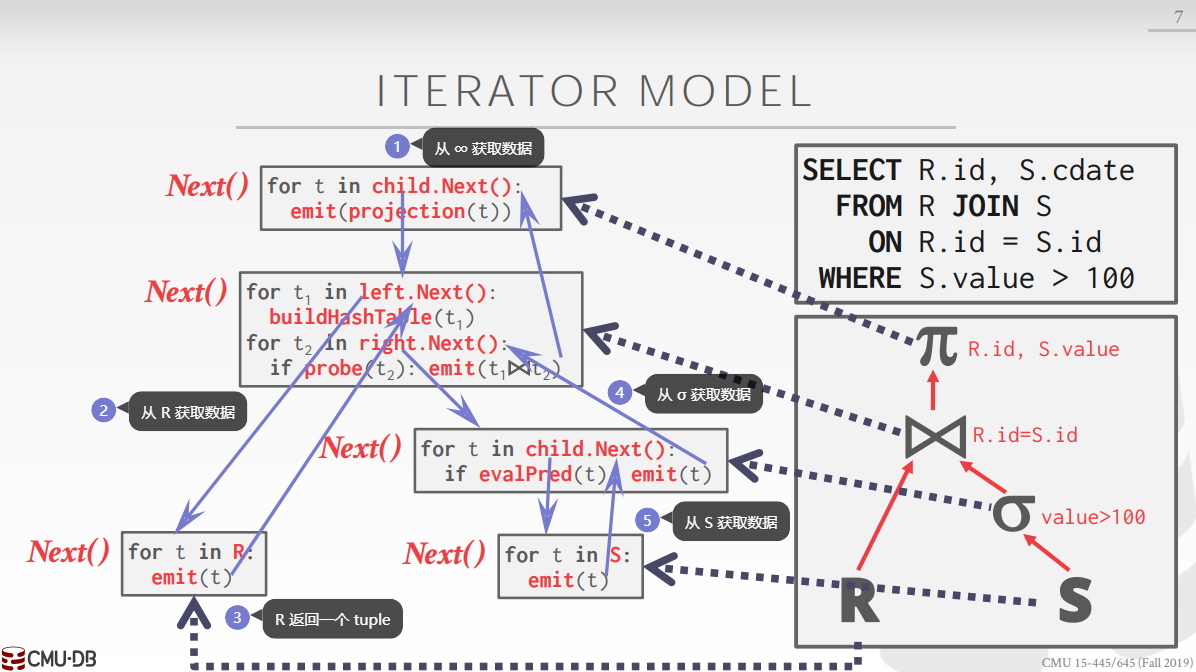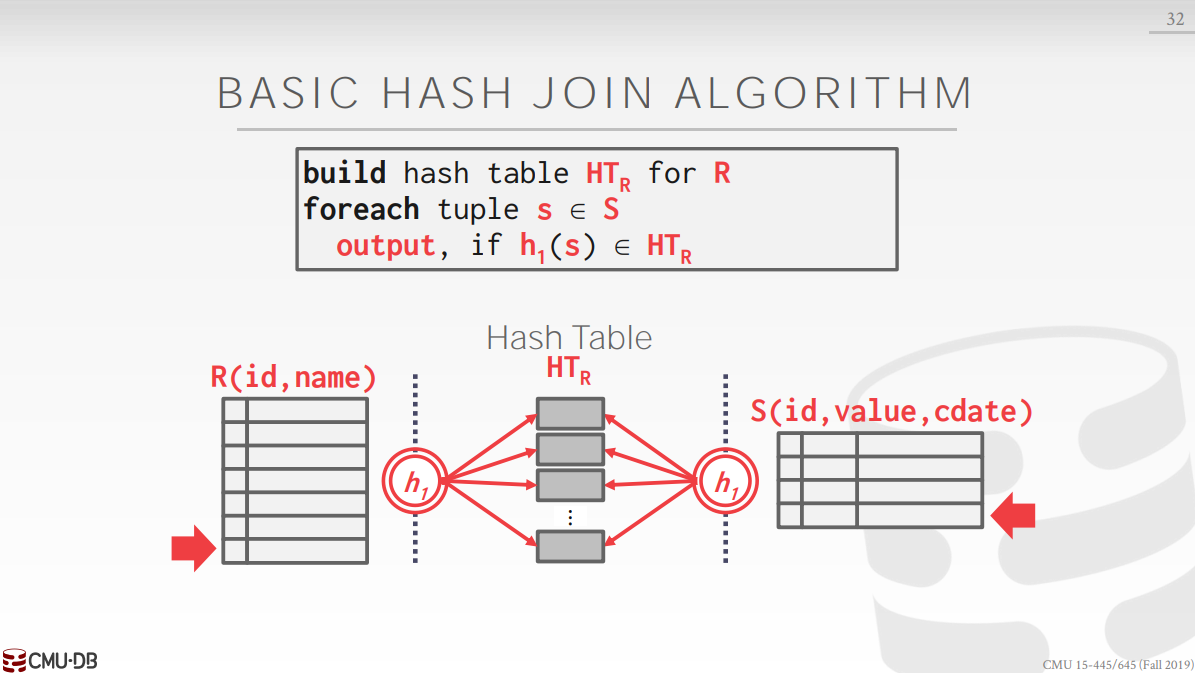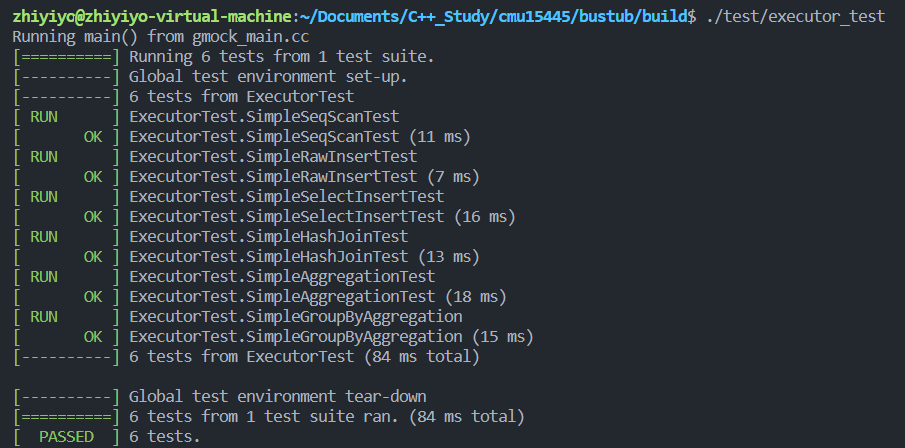CMU15445 (Fall 2019) 之 Project#3
前言
經過前面兩個實驗的鋪墊,終於到了給資料庫系統新增執行查詢計劃功能的時候了。給定一條 SQL 語句,我們可以將其中的操作符組織為一棵樹,樹中的每一個父節點都能從子節點獲取 tuple 並處理成操作符想要的樣子,下圖的根節點 \(\pi\) 會輸出最終的查詢結果。

對於這樣一棵樹,我們獲取查詢結果的方式有許多種,包括:迭代模型、物化模型和向量化模型。本次實驗使用的是迭代模型,每個節點都會實現一個 Next() 函數,用於向父節點提供一個 tuple。從根節點開始,每個父節點每次向子節點索取一個 tuple 並處理之後輸出:

程式碼實現
實驗主要有三個任務:目錄表、執行器和用線性探測雜湊表重新實現 hash join 執行器,下面會一個個介紹這幾個任務的完成過程。
目錄表
目錄表可以根據 table_oid 或者 table_name 返回表的後設資料,其中最重要的一個欄位就是 table_,該欄位表示一張表,用於查詢、插入、修改和刪除 tuple:
using table_oid_t = uint32_t;
using column_oid_t = uint32_t;
struct TableMetadata {
TableMetadata(Schema schema, std::string name, std::unique_ptr<TableHeap> &&table, table_oid_t oid)
: schema_(std::move(schema)), name_(std::move(name)), table_(std::move(table)), oid_(oid) {}
Schema schema_;
std::string name_;
std::unique_ptr<TableHeap> table_;
table_oid_t oid_;
};
目錄表類 SimpleCatalog 中有三個要求我們實現的方法:CreateTable、GetTable(const std::string &table_name) 和 GetTable(table_oid_t table_oid),第一個方法用於建立一個新的表,後面兩個方法用於獲取表:
class SimpleCatalog {
public:
SimpleCatalog(BufferPoolManager *bpm, LockManager *lock_manager, LogManager *log_manager)
: bpm_{bpm}, lock_manager_{lock_manager}, log_manager_{log_manager} {}
/**
* Create a new table and return its metadata.
* @param txn the transaction in which the table is being created
* @param table_name the name of the new table
* @param schema the schema of the new table
* @return a pointer to the metadata of the new table
*/
TableMetadata *CreateTable(Transaction *txn, const std::string &table_name, const Schema &schema) {
BUSTUB_ASSERT(names_.count(table_name) == 0, "Table names should be unique!");
table_oid_t oid = next_table_oid_++;
auto table = std::make_unique<TableHeap>(bpm_, lock_manager_, log_manager_, txn);
tables_[oid] = std::make_unique<TableMetadata>(schema, table_name, std::move(table), oid);
names_[table_name] = oid;
return tables_[oid].get();
}
/** @return table metadata by name */
TableMetadata *GetTable(const std::string &table_name) {
auto it = names_.find(table_name);
if (it == names_.end()) {
throw std::out_of_range("The table name doesn't exist.");
}
return GetTable(it->second);
}
/** @return table metadata by oid */
TableMetadata *GetTable(table_oid_t table_oid) {
auto it = tables_.find(table_oid);
if (it == tables_.end()) {
throw std::out_of_range("The table oid doesn't exist.");
}
return it->second.get();
}
private:
[[maybe_unused]] BufferPoolManager *bpm_;
[[maybe_unused]] LockManager *lock_manager_;
[[maybe_unused]] LogManager *log_manager_;
/** tables_ : table identifiers -> table metadata. Note that tables_ owns all table metadata. */
std::unordered_map<table_oid_t, std::unique_ptr<TableMetadata>> tables_;
/** names_ : table names -> table identifiers */
std::unordered_map<std::string, table_oid_t> names_;
/** The next table identifier to be used. */
std::atomic<table_oid_t> next_table_oid_{0};
};
測試結果如下:

執行器
執行器用於執行查詢計劃,該實驗要求我們實現下述四種執行器:
SeqScanExecutor:順序掃描執行器,遍歷表並返回符合查詢條件的 tuple,比如SELECT * FROM user where id=1通過該執行器獲取查詢結果InsertExecutor:插入執行器,向表格中插入任意數量的 tuple,比如INSERT INTO user VALUES (1, 2), (2, 3)HashJoinExecutor:雜湊連線執行器,用於內連線查詢操作,比如SELECT u.id, c.class FROM u JOIN c ON u.id = c.uidAggregationExecutor:聚合執行器,用於執行聚合操作,比如SELECT MIN(grade), MAX(grade) from user
每個執行器都繼承自抽象類 AbstractExecutor ,有兩個純虛擬函式 Init() 和 Next(Tuple *tuple) 需要實現,其中 Init() 用於初始化執行器,比如需要在 HashJoinExecutor 的 Init() 中對 left table(outer table) 建立雜湊表。AbstractExecutor 還有一個 ExecutorContext 成員,包含一些查詢的後設資料,比如 BufferPoolManager 和上個任務實現的 SimpleCatalog:
class AbstractExecutor {
public:
/**
* Constructs a new AbstractExecutor.
* @param exec_ctx the executor context that the executor runs with
*/
explicit AbstractExecutor(ExecutorContext *exec_ctx) : exec_ctx_{exec_ctx} {}
/** Virtual destructor. */
virtual ~AbstractExecutor() = default;
/**
* Initializes this executor.
* @warning This function must be called before Next() is called!
*/
virtual void Init() = 0;
/**
* Produces the next tuple from this executor.
* @param[out] tuple the next tuple produced by this executor
* @return true if a tuple was produced, false if there are no more tuples
*/
virtual bool Next(Tuple *tuple) = 0;
/** @return the schema of the tuples that this executor produces */
virtual const Schema *GetOutputSchema() = 0;
/** @return the executor context in which this executor runs */
ExecutorContext *GetExecutorContext() { return exec_ctx_; }
protected:
ExecutorContext *exec_ctx_;
};
執行器內部會有一個代表執行計劃的 AbstractPlanNode 的子類資料成員,而這些子類內部又會有一個 AbstractExpression 的子類資料成員用於判斷查詢條件是否成立等操作。
順序掃描
提供的程式碼中為我們實現了一個 TableIterator 類,用於迭代 TableHeap,我們只要在 Next 函數中判斷迭代器所指的 tuple 是否滿足查詢條件並遞增迭代器,如果滿足條件就返回該 tuple,不滿足就接著迭代:
class SeqScanExecutor : public AbstractExecutor {
public:
/**
* Creates a new sequential scan executor.
* @param exec_ctx the executor context
* @param plan the sequential scan plan to be executed
*/
SeqScanExecutor(ExecutorContext *exec_ctx, const SeqScanPlanNode *plan);
void Init() override;
bool Next(Tuple *tuple) override;
const Schema *GetOutputSchema() override { return plan_->OutputSchema(); }
private:
/** The sequential scan plan node to be executed. */
const SeqScanPlanNode *plan_;
TableMetadata *table_metadata_;
TableIterator table_iterator_;
};
實現程式碼如下:
SeqScanExecutor::SeqScanExecutor(ExecutorContext *exec_ctx, const SeqScanPlanNode *plan)
: AbstractExecutor(exec_ctx),
plan_(plan),
table_metadata_(exec_ctx->GetCatalog()->GetTable(plan->GetTableOid())),
table_iterator_(table_metadata_->table_->Begin(exec_ctx->GetTransaction())) {}
void SeqScanExecutor::Init() {}
bool SeqScanExecutor::Next(Tuple *tuple) {
auto predicate = plan_->GetPredicate();
while (table_iterator_ != table_metadata_->table_->End()) {
*tuple = *table_iterator_++;
if (!predicate || predicate->Evaluate(tuple, &table_metadata_->schema_).GetAs<bool>()) {
return true;
}
}
return false;
}
插入
插入操作分為兩種:
- raw inserts:插入資料直接來自插入執行器本身,比如
INSERT INTO tbl_user VALUES (1, 15), (2, 16) - not-raw inserts:插入的資料來自子執行器,比如
INSERT INTO tbl_user1 SELECT * FROM tbl_user2
可以根據插入計劃的 IsRawInsert() 判斷插入操作的型別,這個函數根據子查詢器列表是否為空進行判斷:
/** @return true if we embed insert values directly into the plan, false if we have a child plan providing tuples */
bool IsRawInsert() const { return GetChildren().empty(); }
如果是 raw inserts,我們直接根據插入執行器中的資料構造 tuple 並插入表中,否則呼叫子執行器的 Next 函數獲取資料並插入表中:
class InsertExecutor : public AbstractExecutor {
public:
/**
* Creates a new insert executor.
* @param exec_ctx the executor context
* @param plan the insert plan to be executed
* @param child_executor the child executor to obtain insert values from, can be nullptr
*/
InsertExecutor(ExecutorContext *exec_ctx, const InsertPlanNode *plan,
std::unique_ptr<AbstractExecutor> &&child_executor);
const Schema *GetOutputSchema() override;
void Init() override;
// Note that Insert does not make use of the tuple pointer being passed in.
// We return false if the insert failed for any reason, and return true if all inserts succeeded.
bool Next([[maybe_unused]] Tuple *tuple) override;
private:
/** The insert plan node to be executed. */
const InsertPlanNode *plan_;
std::unique_ptr<AbstractExecutor> child_executor_;
TableMetadata *table_metadata_;
};
實現程式碼為:
InsertExecutor::InsertExecutor(ExecutorContext *exec_ctx, const InsertPlanNode *plan,
std::unique_ptr<AbstractExecutor> &&child_executor)
: AbstractExecutor(exec_ctx),
plan_(plan),
child_executor_(std::move(child_executor)),
table_metadata_(exec_ctx->GetCatalog()->GetTable(plan->TableOid())) {}
const Schema *InsertExecutor::GetOutputSchema() { return plan_->OutputSchema(); }
void InsertExecutor::Init() {}
bool InsertExecutor::Next([[maybe_unused]] Tuple *tuple) {
RID rid;
if (plan_->IsRawInsert()) {
for (const auto &values : plan_->RawValues()) {
Tuple tuple(values, &table_metadata_->schema_);
if (!table_metadata_->table_->InsertTuple(tuple, &rid, exec_ctx_->GetTransaction())) {
return false;
};
}
} else {
Tuple tuple;
while (child_executor_->Next(&tuple)) {
if (!table_metadata_->table_->InsertTuple(tuple, &rid, exec_ctx_->GetTransaction())) {
return false;
};
}
}
return true;
}
雜湊連線
雜湊連線執行器使用的是最基本的雜湊連線演演算法,沒有使用布隆過濾器等優化措施。該演演算法分為兩個階段:
- 將 left table 的 join 語句中各個條件所在列的值作為鍵,tuple 或者 row id 作為值構造雜湊表,這一步允許將相同雜湊值的 tuple 插入雜湊表
- 對 right table 的 join 語句中各個條件所在列的值作為鍵,在雜湊表中進行查詢獲取所以系統雜湊值的 left table 中的 tuple,再使用 join 條件進行精確匹配

對 tuple 進行雜湊的函數為:
/**
* Hashes a tuple by evaluating it against every expression on the given schema, combining all non-null hashes.
* @param tuple tuple to be hashed
* @param schema schema to evaluate the tuple on
* @param exprs expressions to evaluate the tuple with
* @return the hashed tuple
*/
hash_t HashJoinExecutor::HashValues(const Tuple *tuple, const Schema *schema, const std::vector<const AbstractExpression *> &exprs) {
hash_t curr_hash = 0;
// For every expression,
for (const auto &expr : exprs) {
// We evaluate the tuple on the expression and schema.
Value val = expr->Evaluate(tuple, schema);
// If this produces a value,
if (!val.IsNull()) {
// We combine the hash of that value into our current hash.
curr_hash = HashUtil::CombineHashes(curr_hash, HashUtil::HashValue(&val));
}
}
return curr_hash;
}
為了方便我們的測試,實驗提供了一個簡易的雜湊表 SimpleHashJoinHashTable 用於插入 (hash, tuple) 鍵值對,該雜湊表直接整個放入記憶體中,如果 tuple 很多,記憶體會放不下這個雜湊表,所以任務三會替換為上一個實驗中實現的 LinearProbeHashTable。
using HT = SimpleHashJoinHashTable;
class HashJoinExecutor : public AbstractExecutor {
public:
/**
* Creates a new hash join executor.
* @param exec_ctx the context that the hash join should be performed in
* @param plan the hash join plan node
* @param left the left child, used by convention to build the hash table
* @param right the right child, used by convention to probe the hash table
*/
HashJoinExecutor(ExecutorContext *exec_ctx, const HashJoinPlanNode *plan, std::unique_ptr<AbstractExecutor> &&left,
std::unique_ptr<AbstractExecutor> &&right);
/** @return the JHT in use. Do not modify this function, otherwise you will get a zero. */
const HT *GetJHT() const { return &jht_; }
const Schema *GetOutputSchema() override { return plan_->OutputSchema(); }
void Init() override;
bool Next(Tuple *tuple) override;
hash_t HashValues(const Tuple *tuple, const Schema *schema, const std::vector<const AbstractExpression *> &exprs) { // 省略 }
private:
/** The hash join plan node. */
const HashJoinPlanNode *plan_;
std::unique_ptr<AbstractExecutor> left_executor_;
std::unique_ptr<AbstractExecutor> right_executor_;
/** The comparator is used to compare hashes. */
[[maybe_unused]] HashComparator jht_comp_{};
/** The identity hash function. */
IdentityHashFunction jht_hash_fn_{};
/** The hash table that we are using. */
HT jht_;
/** The number of buckets in the hash table. */
static constexpr uint32_t jht_num_buckets_ = 2;
};
根據上述的演演算法過程可以得到實現程式碼為:
HashJoinExecutor::HashJoinExecutor(ExecutorContext *exec_ctx, const HashJoinPlanNode *plan,
std::unique_ptr<AbstractExecutor> &&left, std::unique_ptr<AbstractExecutor> &&right)
: AbstractExecutor(exec_ctx),
plan_(plan),
left_executor_(std::move(left)),
right_executor_(std::move(right)),
jht_("join hash table", exec_ctx->GetBufferPoolManager(), jht_comp_, jht_num_buckets_, jht_hash_fn_) {}
void HashJoinExecutor::Init() {
left_executor_->Init();
right_executor_->Init();
// create hash table for left child
Tuple tuple;
while (left_executor_->Next(&tuple)) {
auto h = HashValues(&tuple, left_executor_->GetOutputSchema(), plan_->GetLeftKeys());
jht_.Insert(exec_ctx_->GetTransaction(), h, tuple);
}
}
bool HashJoinExecutor::Next(Tuple *tuple) {
auto predicate = plan_->Predicate();
auto left_schema = left_executor_->GetOutputSchema();
auto right_schema = right_executor_->GetOutputSchema();
auto out_schema = GetOutputSchema();
Tuple right_tuple;
while (right_executor_->Next(&right_tuple)) {
// get all tuples with the same hash values in left child
auto h = HashValues(&right_tuple, right_executor_->GetOutputSchema(), plan_->GetRightKeys());
std::vector<Tuple> left_tuples;
jht_.GetValue(exec_ctx_->GetTransaction(), h, &left_tuples);
// get the exact matching left tuple
for (auto &left_tuple : left_tuples) {
if (!predicate || predicate->EvaluateJoin(&left_tuple, left_schema, &right_tuple, right_schema).GetAs<bool>()) {
// create output tuple
std::vector<Value> values;
for (uint32_t i = 0; i < out_schema->GetColumnCount(); ++i) {
auto expr = out_schema->GetColumn(i).GetExpr();
values.push_back(expr->EvaluateJoin(&left_tuple, left_schema, &right_tuple, right_schema));
}
*tuple = Tuple(values, out_schema);
return true;
}
}
}
return false;
}
聚合
聚合執行器內部維護了一個雜湊表 SimpleAggregationHashTable 以及雜湊表迭代器 aht_iterator_,將鍵值對插入雜湊表的時候會立刻更新聚合結果,最終的查詢結果也從該雜湊表獲取:
AggregationExecutor::AggregationExecutor(ExecutorContext *exec_ctx, const AggregationPlanNode *plan,
std::unique_ptr<AbstractExecutor> &&child)
: AbstractExecutor(exec_ctx),
plan_(plan),
child_(std::move(child)),
aht_(plan->GetAggregates(), plan->GetAggregateTypes()),
aht_iterator_(aht_.Begin()) {}
const AbstractExecutor *AggregationExecutor::GetChildExecutor() const { return child_.get(); }
const Schema *AggregationExecutor::GetOutputSchema() { return plan_->OutputSchema(); }
void AggregationExecutor::Init() {
child_->Init();
// initialize aggregation hash table
Tuple tuple;
while (child_->Next(&tuple)) {
aht_.InsertCombine(MakeKey(&tuple), MakeVal(&tuple));
}
aht_iterator_ = aht_.Begin();
}
bool AggregationExecutor::Next(Tuple *tuple) {
auto having = plan_->GetHaving();
auto out_schema = GetOutputSchema();
while (aht_iterator_ != aht_.End()) {
auto group_bys = aht_iterator_.Key().group_bys_;
auto aggregates = aht_iterator_.Val().aggregates_;
if (!having || having->EvaluateAggregate(group_bys, aggregates).GetAs<bool>()) {
std::vector<Value> values;
for (uint32_t i = 0; i < out_schema->GetColumnCount(); ++i) {
auto expr = out_schema->GetColumn(i).GetExpr();
values.push_back(expr->EvaluateAggregate(group_bys, aggregates));
}
*tuple = Tuple(values, out_schema);
++aht_iterator_;
return true;
}
++aht_iterator_;
}
return false;
}
測試
測試結果如下圖所示,成功通過所有測試用例:

線性探測雜湊表
這個任務要求將雜湊連線中的 SimpleHashJoinHashTable 更換成 LinearProbeHashTable,這樣就能在磁碟中儲存 left table 的雜湊表。實驗還提示我們可以實現 TmpTuplePage,用於儲存 left table 的 tuple,其實我們完全可以用程式碼中寫好的 TablePage 來實現該目的,但是 TmpTuplePage 結構更為精簡,可以搭配 Tuple::DeserializeFrom 食用,通過實現 TmpTuplePage,我們也能加深對 tuple 儲存方式的理解。
TmpTuplePage 的格式如下所示:
---------------------------------------------------------------------------------------------------------
| PageId (4) | LSN (4) | FreeSpace (4) | (free space) | TupleSize2 | TupleData2 | TupleSize1 | TupleData1 |
---------------------------------------------------------------------------------------------------------
\-----------------V------------------/ ^
header free space pointer
前 12 個位元組是 header,記錄了 page id、lsn 和 free space pointer,此處的 free space pointer 是相對 page id 的地址而言的。如果表中一個 tuple 都沒有,且表大小為 PAGE_SIZE,那麼 free space pointer 的值就是 PAGE_SIZE。tuple 從末尾開始插入,每個 tuple 後面跟著 tuple 的大小(佔用 4 位元組),也就是說插入一個 tuple 佔用的空間大小為 tuple.size_ + 4。
理解上述內容後,實現 TmpTupleHeader 就很簡單了,模仿 TablePage 的寫法即可(需要將 TmpTuplePage 宣告為 Tuple 的友元):
class TmpTuplePage : public Page {
public:
void Init(page_id_t page_id, uint32_t page_size) {
memcpy(GetData(), &page_id, sizeof(page_id));
SetFreeSpacePointer(page_size);
}
/** @return the page ID of this temp table page */
page_id_t GetTablePageId() { return *reinterpret_cast<page_id_t *>(GetData()); }
bool Insert(const Tuple &tuple, TmpTuple *out) {
// determine whether there is enough space to insert tuple
if (GetFreeSpaceRemaining() < tuple.size_ + SIZE_TUPLE) {
return false;
}
// insert tuple and its size
SetFreeSpacePointer(GetFreeSpacePointer() - tuple.size_);
memcpy(GetData() + GetFreeSpacePointer(), tuple.data_, tuple.size_);
SetFreeSpacePointer(GetFreeSpacePointer() - SIZE_TUPLE);
memcpy(GetData() + GetFreeSpacePointer(), &tuple.size_, SIZE_TUPLE);
out->SetPageId(GetPageId());
out->SetOffset(GetFreeSpacePointer());
return true;
}
private:
static_assert(sizeof(page_id_t) == 4);
static constexpr size_t SIZE_TABLE_PAGE_HEADER = 12;
static constexpr size_t SIZE_TUPLE = 4;
static constexpr size_t OFFSET_FREE_SPACE = 8;
/** @return pointer to the end of the current free space, see header comment */
uint32_t GetFreeSpacePointer() { return *reinterpret_cast<uint32_t *>(GetData() + OFFSET_FREE_SPACE); }
/** set the pointer of the end of current free space.
* @param free_space_ptr the pointer relative to data_
*/
void SetFreeSpacePointer(uint32_t free_space_ptr) {
memcpy(GetData() + OFFSET_FREE_SPACE, &free_space_ptr, sizeof(uint32_t));
}
/** @return the size of free space */
uint32_t GetFreeSpaceRemaining() { return GetFreeSpacePointer() - SIZE_TABLE_PAGE_HEADER; }
};
在 Insert 函數中更新了 TmpTuple 的引數,我們會將 TmpTuple 作為 left table 雜湊表的值,而 tuple 放在 TmpTuplePage 中,根據 TmpTuple 中儲存的 offset 獲取 tuple:
class TmpTuple {
public:
TmpTuple(page_id_t page_id, size_t offset) : page_id_(page_id), offset_(offset) {}
inline bool operator==(const TmpTuple &rhs) const { return page_id_ == rhs.page_id_ && offset_ == rhs.offset_; }
page_id_t GetPageId() const { return page_id_; }
size_t GetOffset() const { return offset_; }
void SetPageId(page_id_t page_id) { page_id_ = page_id; }
void SetOffset(size_t offset) { offset_ = offset; }
private:
page_id_t page_id_;
size_t offset_;
};
接著需要將雜湊表更換為 LinearProbeHashTable,在 linear_probe_hash_table.cpp 中需要進行模板特例化:
template class LinearProbeHashTable<hash_t, TmpTuple, HashComparator>;
還要對 HashTableBlockPage 進行模板特例化:
template class HashTableBlockPage<hash_t, TmpTuple, HashComparator>;
接著更改 HT:
using HashJoinKeyType = hash_t;
using HashJoinValType = TmpTuple;
using HT = LinearProbeHashTable<HashJoinKeyType, HashJoinValType, HashComparator>;
由於 tuple 可能很多,將 jht_num_buckets_ 設定為 1000 可以減少調整大小的次數,最後是實現程式碼:
void HashJoinExecutor::Init() {
left_executor_->Init();
right_executor_->Init();
// create temp tuple page
auto buffer_pool_manager = exec_ctx_->GetBufferPoolManager();
page_id_t tmp_page_id;
auto tmp_page = reinterpret_cast<TmpTuplePage *>(buffer_pool_manager->NewPage(&tmp_page_id)->GetData());
tmp_page->Init(tmp_page_id, PAGE_SIZE);
// create hash table for left child
Tuple tuple;
TmpTuple tmp_tuple(tmp_page_id, 0);
while (left_executor_->Next(&tuple)) {
auto h = HashValues(&tuple, left_executor_->GetOutputSchema(), plan_->GetLeftKeys());
// insert tuple to page, creata a new temp tuple page if page if full
if (!tmp_page->Insert(tuple, &tmp_tuple)) {
buffer_pool_manager->UnpinPage(tmp_page_id, true);
tmp_page = reinterpret_cast<TmpTuplePage *>(buffer_pool_manager->NewPage(&tmp_page_id)->GetData());
tmp_page->Init(tmp_page_id, PAGE_SIZE);
// try inserting tuple to page again
tmp_page->Insert(tuple, &tmp_tuple);
}
jht_.Insert(exec_ctx_->GetTransaction(), h, tmp_tuple);
}
buffer_pool_manager->UnpinPage(tmp_page_id, true);
}
bool HashJoinExecutor::Next(Tuple *tuple) {
auto buffer_pool_manager = exec_ctx_->GetBufferPoolManager();
auto left_schema = left_executor_->GetOutputSchema();
auto right_schema = right_executor_->GetOutputSchema();
auto predicate = plan_->Predicate();
auto out_schema = GetOutputSchema();
Tuple right_tuple;
while (right_executor_->Next(&right_tuple)) {
// get all tuples with the same hash values in left child
auto h = HashValues(&right_tuple, right_executor_->GetOutputSchema(), plan_->GetRightKeys());
std::vector<TmpTuple> tmp_tuples;
jht_.GetValue(exec_ctx_->GetTransaction(), h, &tmp_tuples);
// get the exact matching left tuple
for (auto &tmp_tuple : tmp_tuples) {
// convert tmp tuple to left tuple
auto page_id = tmp_tuple.GetPageId();
auto tmp_page = buffer_pool_manager->FetchPage(page_id);
Tuple left_tuple;
left_tuple.DeserializeFrom(tmp_page->GetData() + tmp_tuple.GetOffset());
buffer_pool_manager->UnpinPage(page_id, false);
if (!predicate || predicate->EvaluateJoin(&left_tuple, left_schema, &right_tuple, right_schema).GetAs<bool>()) {
// create output tuple
std::vector<Value> values;
for (uint32_t i = 0; i < out_schema->GetColumnCount(); ++i) {
auto expr = out_schema->GetColumn(i).GetExpr();
values.push_back(expr->EvaluateJoin(&left_tuple, left_schema, &right_tuple, right_schema));
}
*tuple = Tuple(values, out_schema);
return true;
}
}
}
return false;
}
測試結果如下:

總結
通過這次實驗,可以加深對目錄、查詢計劃、迭代模型和 tuple 頁佈局的理解,算是收穫滿滿的一次實驗了,以上~~